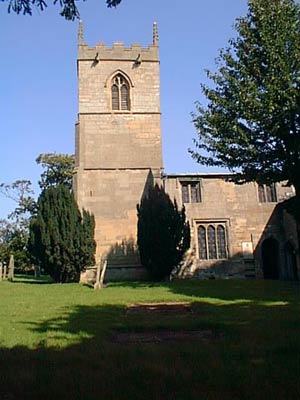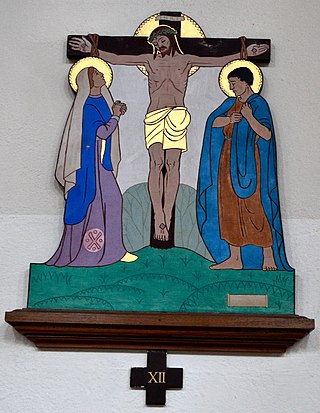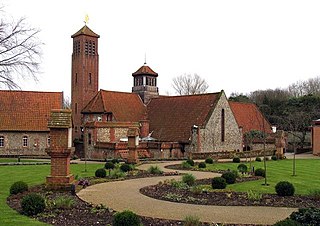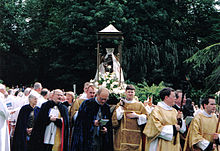
A shrine to the Virgin Mary, or Marian shrine, is a shrine marking an apparition or other miracle ascribed to the Blessed Virgin Mary, or a site on which is centered a historically strong Marian devotion. Such locales are often the destinations of Christian pilgrimages.

Walsingham is a civil parish in North Norfolk, England, famous for its religious shrines in honour of Mary, mother of Jesus. It also contains the ruins of two medieval monastic houses. Walsingham is 27 miles northwest of Norwich.
Our Lady of Ipswich was a popular English Marian shrine before the English Reformation. Among Marian shrines, only the shrine at Walsingham attracted more visitors.

Marian devotions are external pious practices directed to the person of Mary, mother of Jesus, by members of certain Christian traditions. They are performed in Catholicism, High Church Lutheranism, Anglo-Catholicism, Eastern Orthodoxy and Oriental Orthodoxy, but generally rejected in other Christian denominations.

Our Lady of Walsingham is a title of Mary, mother of Jesus venerated by Catholics and High Church Anglicans associated with the Marian apparitions to Richeldis de Faverches, a pious English noblewoman, in 1061 in the village of Walsingham in Norfolk, England. Lady Richeldis had a structure built named "The Holy House" in Walsingham which later became a shrine and place of pilgrimage.
Anglican Marian theology is the summation of the doctrines and beliefs of Anglicanism concerning Mary, mother of Jesus. As Anglicans believe that Jesus was both human and God the Son, the second Person of the Trinity, within the Anglican Communion and Continuing Anglican movement, Mary is accorded honour as the theotokos, a Koiné Greek term that means "God-bearer" or "one who gives birth to God".

The Church of Our Lady of Egmanton is a Church of England parish church in Egmanton, Nottinghamshire, and the location of the Shrine of Our Lady of Egmanton.

The Basilica of Our Lady of Walsingham, informally known as the Slipper Chapel or the Chapel of Saint Catherine of Alexandria, is a Catholic basilica in Houghton Saint Giles, Norfolk, England. Built in 1340, it was the last chapel on the pilgrim route to Walsingham.

Alfred Hope Patten, known as "Pat" to his friends, was an Anglo-Catholic priest in the Church of England, best known for his restoration of the Anglican Shrine of Our Lady of Walsingham.
Our Lady of Grace is a Title of Mary. The feast day associated with this title is February 7. The title of Our Lady of Grace is venerated in many countries throughout the world under various aspects. Many parishes, churches, and schools bear this name.
Mowbray Stephen O'Rorke was an Anglican bishop in Africa in the first quarter of the 20th century.

Our Lady of Willesden is a title of the Blessed Virgin Mary venerated by Christians in London, especially by Anglicans and Catholics. It is associated with the historic image (statue) and pilgrimage centre in the community of Willesden, originally a village in Middlesex, England, but now a suburb of London. The pre-Reformation shrine was home to the Black Madonna of Willesden statue.

Enid Mary Chadwick was a British artist known for religious art and children's religious material.

The Anglican Shrine of Our Lady of Walsingham is a Church of England shrine church built in 1938 in Walsingham, Norfolk, England. Walsingham is the site of the reputed Marian apparitions to Richeldis de Faverches in 1061. The Virgin Mary is therefore venerated at the shrine with the title of Our Lady of Walsingham.

Saint Bede Catholic Church in James City County and Williamsburg, Virginia, is a Catholic parish in the Diocese of Richmond. The National Shrine of Our Lady of Walsingham, located adjacent to the campus of the College of William & Mary, is a part of the parish. It was the first Catholic church in Williamsburg.
St Mary and All Saints Church is the parish church of Little Walsingham in the English county of Norfolk. It is dedicated to the Virgin Mary and All Saints. Little Walsingham was the location of the shrine of Our Lady of Walsingham, destroyed at the Dissolution. The Anglican shrine was revived by Alfred Hope Patten, the Vicar of Little Walsingham, in 1922, and the image of Our Lady of Walsingham was in the church until its translation to the new priory in 1931.
Michael Yelton is an English lay authority of the history of the Church of England, particularly the Anglo-Catholic movement. He is secretary of the Anglo-Catholic History Society and a retired as a county court judge on 22 April 2020.
Albert Ernest Frost was an English Anglican priest who was persecuted for Anglo-Catholic practices in Australia. He subsequently returned to England and became an Anglican Benedictine and a noted spiritual writer.

Our Lady of the Annunciation Church is a Roman Catholic parish church in King's Lynn, Norfolk, England. It was built in 1897, but incorporates parts of the former church on the same site that was built in 1845 and designed by Augustus Pugin. It is located on the corner of London Road and North Everard Street in the centre of the town. Its construction was partially paid for by the then Prince of Wales, Edward VII. It was also the national shrine of Our Lady of Walsingham until 1934. It is now a pontifical shrine, and was awarded Grade II listed status in 2022.
St. James Church, located at 1681 E. 55th St., Cleveland, Ohio, was founded in 1857 as a mission of Trinity Episcopal Church. The first church was built in 1864-66 in an English settlement neighborhood at Superior Ave. and Alabama. Rev. Richard Bury served until 1871, and the congregation was small and financially struggling. On October 10, 1890, the existing church on E. 55th at Whittier was dedicated.













